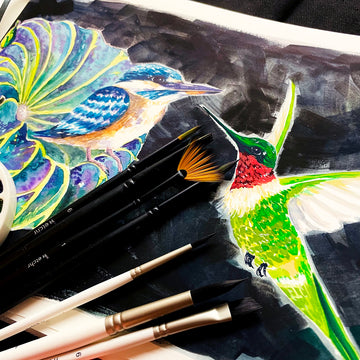
In parts 1 and 2, we covered the basics of choosing a paintbrush in terms of its material makeup and shape. This time, let’s dive even deeper to see how to pick a paintbrush based on the art being made – with a focus that also covers the differences between the brush sets offered by Etchr.
A Matter of Media

One of the first questions you’ll need to answer that will help your choice is to determine your primary medium. Watercolour sits at the top in terms of transparency and “delicacy”, which means it often requires a softer touch.
That soft touch is why natural- or blended-hair paintbrushes are perfect for the watercolourist, as they can hold a lot of water and create great wet-in-wet effects. Other media don’t require adding as much water to the paints because there’s less need to create the kind of transparency for which watercolour is known.
However, this doesn’t mean that synthetic brushes aren’t good for watercolours either. The great thing about watercolour is that it works with synthetic brushes, even if they don’t hold as much water. It is doubly true for good quality synthetic brushes, which perform almost as well as natural brushes.
Both sets of Etchr brushes fall into this category, as both have brushes with bristles that come to a fine point (or edge) and hold a decent amount of water despite being synthetic brushes.
The watercolour paintbrush set offers a wide range of shapes and sizes, though the bristles are stiffer because they’re not as fine as the gouache set. Stiffer bristles mean they’re easier to control, which makes them great for beginners, but they might feel a bit stiff for those looking for a softer touch.
On the other hand, the gouache set is also quite suitable for watercolours, as the thinner bristles make them feel almost like natural hair paintbrushes. They still have a good amount of spring, too, making them more balanced than the watercolour brush set.

Both brush sets can be used for all water-based paints, like gouache or poster paints. The stiffer bristles of the watercolour set might give your brushstrokes more texture (depending on how thick your paint is); otherwise their performance is pretty much the same.
As for even denser media like acrylics or oils, you could use the watercolour set’s thicker-bristled brushes to paint, especially for acrylic, though oil usually requires even thicker bristles, so they don’t get destroyed as quickly during the cleaning process.
In most cases, though, I recommend using one set of paintbrushes per medium, as you’ll find that particular brush sets simply feel better with certain paints than with others. Brush preference is especially true for water-based paints versus oil-based paints because they flow and react differently. Brushes used for denser paint also tend to wear out more quickly, so try not to spend too much on these paintbrushes.
A Question of Style

You’ll need to consider the other major factor: your preferred painting style and subject(s). If you like painting landscapes or something more organic and natural, I recommend mainly having round paintbrushes, with a few large mop brushes for broader coverage.
If you like painting cityscapes or something with straighter edges, I recommend mainly having flat paintbrushes to get straighter lines. Alternatively, if your style leans on the “blockier” side, you can also use flat brushes to achieve this – kind of like using a palette knife when painting with acrylics or oils. You can see an example of what this looks like in the above image.
Generally speaking, it’s still good to have at least one round and one flat brush. If you’re someone who needs to paint a lot of precise details, I recommend adding a rigger brush (i.e. a round brush with longer bristles) or at least a smaller round brush to your set.
A dagger brush is good for painting large areas with precise edges, while a filbert (a flat brush with a curved edge) is good for painting smooth curves and rounding off edges.
If you haven’t quite found your style, I recommend trying Etchr’s watercolour paintbrush set because the extra brushes mean there are a few more shapes and sizes to experiment with, including the fan brush.
See which brushes you find yourself using the most! Knowing your go-to brushes will give you a better idea of how you like to work and which type of brush you prefer to use.
Suppose you prefer brushes with a softer feel and like working with mostly round or flat brushes. In that case, I recommend Etchr’s gouache paintbrush set instead, as they’re similar to natural hair brushes without having to break the bank.
The great thing about both sets is that they offer enough versatility in paintbrush shapes and sizes, plus they both come with a convenient roll-up travel pouch.
Final Thoughts

Either way, both Etchr brush sets offer slightly different things at the same price, so the choice comes down to personal preference. Hopefully, this blog post has helped clarify the factors involved when looking at different paintbrush sets!
While it’s hard to know without trying them for yourself, sometimes you need to take the leap and try something new. Personally, having tried both of Etchr’s paintbrush sets (and many more from other shops!), I can say that Etchr makes some of the best synthetic brushes at their price, so you’re guaranteed to get a lot of good use out of either set, no matter what kind of artist you are.
Do you own any of Etchr’s paintbrush sets? If so, which one did you get? If you have both, which set do you prefer? Share with us in the comments!


